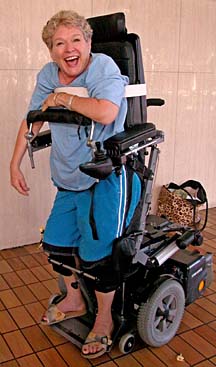
CRAIG T. KOJIMA / CKOJIMA@STARBULLETIN.COM
Peggy Chun pulls Lance Magin with her electric wheelchair at the Pacific Beach Hotel.
New wheelchair
lifts artistPeggy Chun, who has Lou
Gehrig's disease, says she feels
"like a normal human being"
Like a kid with a new toy, artist Peggy Chun showed all the things her customized electric wheelchair can do to improve her life with Lou Gehrig's disease.
"Right now, I feel like a normal human being, just sitting in this chair," she said after it arrived from the mainland last week.
"Watch what happens. It goes up. Now I'm as tall as I was when I was 5 feet 1 inch. Of course, this isn't the most flattering view," she said, making it lie back. "Look, it stretches my back when I'm sitting forward."
CRAIG T. KOJIMA / CKOJIMA@STARBULLETIN.COM
Chun's wheelchair rises so she can stand.
Most important, it can stand her up, she said, slowly moving into an upright position. "My gosh, you can't believe how wonderful this is. I can feel the pressure of my feet. ... My bones are saying, 'Thank you so much.'"
Chun, 57, was diagnosed in March last year with ALS, or amyotrophic lateral sclerosis, a fatal neuromuscular disease that causes progressive muscle weakness and paralysis. It is more commonly known as Lou Gehrig's disease, named for the New York Yankees star who died of the disease in 1941.
Her twin sister, Bobbie Segler, and their mother and grandfather died of ALS.
Chun said her right side now is "pretty much paralyzed."
When her right hand began dragging and she couldn't lift it while painting, she switched to her left hand and kept painting.
"I didn't know I could. It happened in one hour," Chun said about painting with her left hand.
Chun acknowledges that "it's easy to give in to depression" as the disease worsens. But she has a cheerful, even humorous outlook. She feels "very blessed" to have strong support from family, friends and health professionals.
"My neurologist said people with a support system live longer."
Friends held fund-raisers to help her get a wheelchair, which she said will prevent bedsores and keep her circulation going. "I am so mobile now," she said, explaining she is able to paint comfortably now for hours.
"She's doing awesome," said Lance Magin, 46, a wheelchair athlete who broke his back motorcycle racing at age 17.
A friend of Chun's knows Magin's boss at Mesa Medical Equipment in Las Vegas, where he is marketing director, and his boss told him she was looking for a power chair, he said.
The one she wanted retails for $27,000, and he found a demonstration model to send her for $19,000, he said. Magin also came to Hawaii last week to help Chun learn to use the wheelchair.
Magin said Chun's 350-pound electric chair is like a Hummer while his 20-pound, hand-controlled chair is more like a Ferrari.
He is the first paraplegic to hold a National Association of Stock Car Racing (NASCAR) license. He races for sponsors such as Ford Motor Co. and Goodyear Tire Co. He is also a snow-, water- and jet-skier and wheelchair tennis champion.
One year after his accident, he became the first paraplegic to race the Baja 1000, using hand controls. Then, suffering from depression and self-pity and unaware of "what life had to offer in a chair," he spent 10 years drinking and using drugs, he said.
After "a lot of hitting walls" and a motorcycle-racing friend asked him, "What's more important -- racing or partying?" he chose racing.
He began wheelchair tennis and water-skiing in San Diego, defeating the top-ranked wheelchair tennis player in the world in 1986 and ranking 10th in World Wheelchair Games in 1987. In Reno he began truck and car racing with hand controls, getting his NASCAR license in 1996.
Magin, who shares his experiences with people with spinal cord injuries and other disabilities, encouraged Chun as she tested her chair.
"Look at my carbon fiber body; that's what all the guys notice first," she said, noting the wheelchair can travel 5 mph, climb a 3-inch curb and logs 22 miles on a single charge.
"I am the most comfortable, happy person," she said, describing a busy schedule that includes teaching a painting class once a week and swimming weekly off the Kaimana Beach Hotel, assisted by friends and a canvas wheelchair with inflated tires.
Chun lives in Nuuanu with her husband, three cats and about 75 people who are in and out at different times helping the family. They were organized with advice from the book "Share the Care," which Chun highly recommends to others with disabilities.
She takes Rilutek, the only medication approved by the Federal Drug Administration for ALS, as well as anti-inflammatory medication and injections of a powerful antioxidant. One drug alone costs $800 a month, which her HMSA plan covers, she said.
"The rest is amazing naturopathic stuff," she said. With diets, supplements and massages, Chun said she believes the disease's progress has been slowed.
Although she has been "anxious and sad" at times, she said: "I'm happier now than I've ever been. It's been one hell of an adventure after the diagnosis."

